
The Armstrong Siddeley Mongoose is a British five-cylinder radial aero engine produced by Armstrong Siddeley. Developed in the mid-1920s it was used in the Hawker Tomtit trainer and Parnall Peto seaplane amongst others. With a displacement of 540 cubic inches (9 litres) the Mongoose had a maximum power output of 155 horsepower (115 kilowatts).
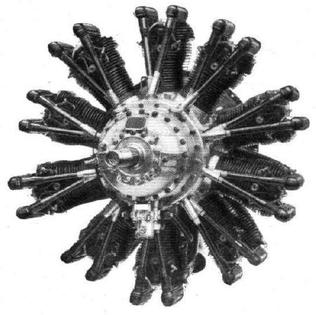
The Armstrong Siddeley Serval was a British ten-cylinder aero engine developed by Armstrong Siddeley in the late 1920s. Following company tradition, the engine was named for the serval.

The Armstrong Siddeley Genet Major is a British five-cylinder, air-cooled, radial engine for aircraft, designed and built by Armstrong Siddeley and first run in 1928. It developed 140 horsepower (104 kW). In Royal Air Force use the seven-cylinder version was known as the Civet I. The Feliform names used are in line with company convention, the Genet and Civet both being large cat-like carnivores.

The Rolls-Royce Exe, or Boreas, was a 24-cylinder air-cooled X block sleeve valve aircraft engine intended primarily for the new Fairey Fleet Air Arm aircraft, particularly the Fairey Barracuda. The Exe was relatively powerful for its era, producing about 1,100 hp. This is notable given the relatively small 22 litres displacement, the Merlin requiring 27 litres for approximately the same power level. The X-24 layout made this quite a compact engine.

The Napier Rapier was a British 16-cylinder H pattern air-cooled aero engine designed by Frank Halford and built by Napier & Son shortly before World War II.

The ABC Wasp was an experimental 170 hp (127 kW) seven-cylinder radial engine designed by the noted British engineer Granville Bradshaw, and primarily built by ABC Motors Limited. Twelve experimental ABC Wasp engines were delivered to Guy Motors on 19 April 1918.
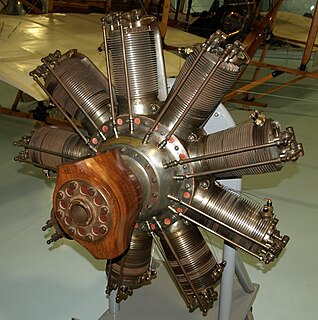
The Clerget 9B was a nine-cylinder rotary aircraft engine of the World War I era designed by Pierre Clerget. Manufactured in both France and Great Britain, it was used on such aircraft as the Sopwith Camel. The Clerget 9Bf was an increased stroke version.

The ABC Dragonfly was a British radial engine developed towards the end of the First World War. It was expected to deliver excellent performance for the time and was ordered in very large numbers. It proved, however, to be extremely unreliable and was abandoned when its faults were unable to be corrected.
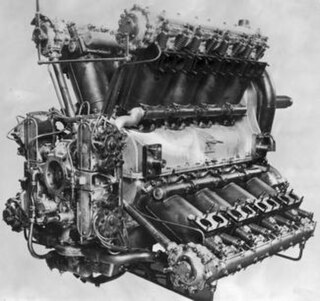
The Napier Cub was an unusual and very large experimental 1,000 horsepower (750 kW) 16-cylinder 'X' pattern liquid-cooled aero engine built by the British engine company D. Napier & Son. The Cub was the only Napier 'X' engine design. First flown on 15 December 1922 in an Avro Aldershot biplane bomber aircraft, the only other application was in the Blackburn Cubaroo. Only six engines of this type were ordered and produced.

The Napier Culverin was a licensed built version of the Junkers Jumo 204 six-cylinder vertically opposed liquid-cooled diesel aircraft engine built by D. Napier & Son. The name is derived from the French word, culverin, for an early cannon or musket. First flown in 1938, the engine went into limited production, with testing carried out on a Blackburn Iris V biplane flying-boat aircraft and Fairey IIIF biplane.

The ADC Airdisco is a British V-8 aero engine that first ran in 1925.

The Renault 80 hp, or Type WS in British service, was a V-8 aero engine that first ran in 1914. The engine was manufactured in Britain by Renault Limited of West Brompton, London between August 1914 and December 1918, seven other companies, including Rolls-Royce and Brazil Straker, also produced the engine. The Renault V-8 engines were noted as inefficient but reliable, the inefficiency being mainly due to the excessively rich fuel/air mixture used to assist cooling.
The RAF 3 was a British liquid-cooled, V-12 engine developed for aircraft use during World War I. Based on the eight–cylinder RAF 1 it was designed by the Royal Aircraft Factory but produced by the two British companies of Armstrong Whitworth and Napier & Son. The RAF 7 was a high compression version of the same engine.
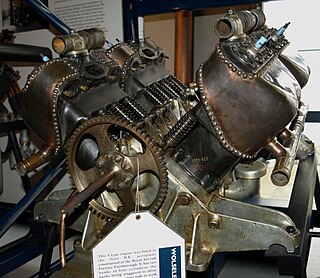
The Wolseley 60 hp or Type C was a British liquid-cooled V-8 aero engine that first ran in 1910, it was designed and built by Wolseley Motors. The engine featured water-cooled exhaust ports and employed a 20 lb (9 kg) flywheel. During an official four-hour test the engine produced an average of 55 horsepower. A larger capacity variant known as the 80 hp or Type B used an internal camshaft and propeller reduction gear.

The Beardmore 120 hp was a British six-cylinder, water-cooled aero engine that first ran in 1914, it was built by William Beardmore and Company as a licensed-built version of the Austro-Daimler 6. The engine featured cast iron cylinders and mild steel concave pistons. Produced between August 1914 and December 1918, the design powered many World War I aircraft types.
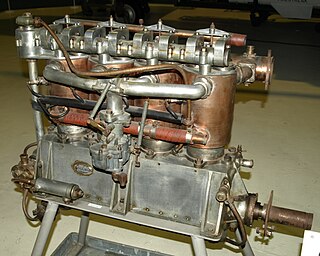
The Green C.4 was a British four-cylinder, water-cooled aero engine that first ran in 1908, it was designed by Gustavus Green and built by the Green Engine Co and Aster Engineering. The engine was one of two Green designs to win a government prize.
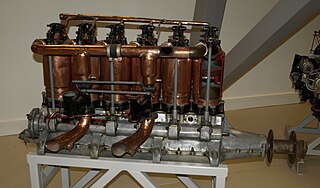
The Beardmore 160 hp is a British six-cylinder, water-cooled aero engine that first ran in 1916, it was built by Arrol-Johnston and Crossley Motors for William Beardmore and Company as a development of the Beardmore 120 hp, itself a licensed-built version of the Austro-Daimler 6.

The Green D.4 was a four-cylinder watercooled inline piston engine produced by the Green Engine Co in the UK in 1909. It produced about 60 hp (45 kW) and played an important role in the development of British aviation before World War I.
The Clerget 11Eb was an 11-cylinder rotary aircraft engine of the World War I era designed by Pierre Clerget. Powering Sopwith types it was nominally rated at 200 horsepower (150 kW).
The Clerget 7Z was a seven-cylinder rotary aircraft engine of the World War I era designed by Pierre Clerget. First appearing in 1911 it was nominally rated at 80 horsepower (60 kW). 347 examples were jointly built in Britain by Gordon Watney & Co Ltd of Weybridge and Gwynnes Limited of Hammersmith.

























